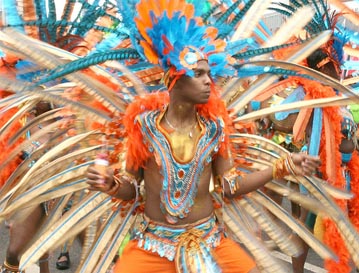Copyright
notice.
All articles published on this website remain the copyright ©
of
Linguapress.com and/or their individual authors.
Reproduction is authorised exclusively for use by students for personal
use, or for teachers for use in class
|
Linguapress.com
Languages
and area studies portal
Advanced
level EFL resource
|
| Notting Hill - Europe's
biggest carnival |
When, in 1964, a members of a
Trinidadian steel band were invited
to take part in a street festival in Notting Hill, none of them
realised that they were going to give birth to Europe’s
greatest street carnival.
There had been racial tension in the
late 1950’s, and the Black people who had come over from the
West Indies to work in London found it hard to mix with Londoners. As a
way of breaking the ice, the idea of a street festival was suggested;
street festivals being popular events on the Caribbean islands, the
original organisers suggested that the sight and sound of a Trinidadian
steel band playing on the streets of Notting Hill would encourage local
residents, both black and white, to come out on the street and enjoy
themselves for an afternoon.
The first festival was an immediate
success; once the black people of Notting Hill heard the music of the
steel band, they came out into the street to dance and enjoy themselves
as they might have done back home in the West Indies;
attracted by the unusual and rhythmic sound of the steel band, others
too came along to share in the experience. In short, the first festival
was such a big success that the organisers decided to organise another
one the following year.
 Since then, the Notting Hill Carnival has evolved into a huge
multi-cultural arts festival, attended by
up to two million people; besides being the annual high point of
London’s Afro-Caribbean community, it now attracts hundreds
of thousands of people from all over Britain and other countries, and
has become the world’s second biggest carnival, second only
to Rio.
Since then, the Notting Hill Carnival has evolved into a huge
multi-cultural arts festival, attended by
up to two million people; besides being the annual high point of
London’s Afro-Caribbean community, it now attracts hundreds
of thousands of people from all over Britain and other countries, and
has become the world’s second biggest carnival, second only
to Rio.
Over the years, the carnival has grown
in variety, reflecting the multi-coloured and cosmopolitan nature of
modern London; recent carnivals have seen the participation of groups
from Afghanistan, Kurdistan, Bangladesh, Bulgaria, Russia, and many
other countries, as well as musicians and dancers from other parts of
Britain. In addition to the procession of exotic costumes and steel
bands, there are now almost fifty static stages
with bands playing different types of West Indian music, but also jazz,
soul, and other popular varieties.
With so many people in attendance during
the two days of the festival - the last Sunday and Monday in August -
moments of tension and the occasional scuffles
with the police are inevitable; yet in spite of the crowds, serious
problems are rare. The vast majority of those who come to this festival
come to have a good time, to finish off the Summer holiday period with
a day or two of exoticism and colour; they do not come looking for
trouble.
FROM
TRINIDAD TO LONDON
In Trinidad during the days of slavery,
black slaves were forbidden to play musical instruments and wear
costumes except on the occasion of the traditional imported European
carnival, that took place six weeks before Easter. Slaves were also
forbidden to be on the streets after dark, unless they were
accompanying their master.
When slavery was abolished in British
colonies in 1833, slaves took to the streets in song and dance; to
celebrate their new-found freedom, they dressed up in fancy
and colourful clothes and powdered their faces white, to mimic their
former masters and show that they could be masters too.
In the years that followed, as slavery
eventually disappeared from other parts of the new World, carnivals
developed into great moments of celebration for the former slaves
throughout a large part of the region; from Rio to New Orleans, by way
of the Caribbean, people vied with
each other to produce the most exotic and exciting carnival costumes.
Even in 19th century Trinidad, it was amazing what some people managed
to produce using the very limited resources available to them.
Today the situation is quite different;
and although many Carnival costumes are now made up from left-overs
and snippets,
others are carefully made from material bought specially for the purpose.
Yet regardless of how the costumes are made, the result is spectacular;
a flamboyant display of colour and originality that has earned itself a
highly deserved place as the most important annual street festival in
Britain.
Word
guide:
steel band:
percussion band with home made instruments - enjoy themselves:
amuse themselves, have fun - West
Indies: Caribbean islands - attended by: visited
by - static stage:
fixed platform - in
attendance: present - scuffle:
struggle, small fight - fancy:
fantastic, fantasy - vie:
compete - left overs:
surplus and unused material - snippets: small
pieces cut from a big piece (to snip
= to cut) - purpose:
reason .
Photo:Notting Hill
Carnival in 2008 - licence CC by Jig O'Dance |
Creative writing exercise:
Students should imagine that
they have just visited the Notting Hill Carnival, and describe their
day there, using each of the following words or phrases in this order:
arrive - lots of - very loud -
costumes - he told me that - shouting -
police - five minutes -
good time - next year. |
|
|
|
|
|